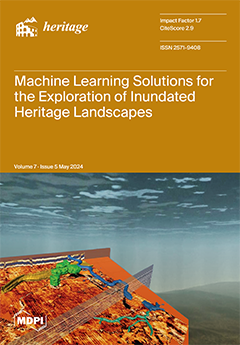The Hispanic Society Museum & Library (HSML) holds a collection of nine viceregal
barniz de Pasto objects, made by Indigenous artisans in the 17th and 18th centuries. Designed to imitate Asian lacquers and intended for European aesthetic tastes,
barniz de Pasto is an
[...] Read more.
The Hispanic Society Museum & Library (HSML) holds a collection of nine viceregal
barniz de Pasto objects, made by Indigenous artisans in the 17th and 18th centuries. Designed to imitate Asian lacquers and intended for European aesthetic tastes,
barniz de Pasto is an example of Indigenous technique and knowledge that has survived to the present day. An in-depth analysis of five of these
barniz de Pasto objects, dated to the first half and last quarter of the 17th century based on their iconography, was carried out through a combination of non-invasive and micro-invasive techniques, including portable X-ray fluorescence (pXRF) spectroscopy to investigate the possible presence of inorganic pigments, and fiber-optics reflectance spectroscopy (FORS) and reflectance imaging spectroscopy (RIS) to provide molecular information on colorants and their distributions across the objects. Dyes and pigments were also identified using Raman spectroscopy, Fourier-transform infrared (FTIR) spectroscopy, and liquid chromatography/mass spectrometry (LC/MS). The nature of the resin was determined by FTIR and pyrolysis-gas chromatography/mass spectrometry (Py-GC/MS), while the decoration stratigraphy and composition were analyzed by scanning electron microscopy with energy-dispersive X-ray spectroscopy (SEM-EDS). This paper confirms the use of
mopa mopa, the resin used in the
barniz de Pasto technique, in two objects not previously analyzed, and identifies indigo, insect-based red, calomel, lead white, and an unknown flavonol-based yellow dye, and challenges the use of calomel as a temporal marker for these works. Taken together, these results expand our understanding of the material use and explorations undertaken by artists during this time period to create such elaborate and enduring objects.
Full article





